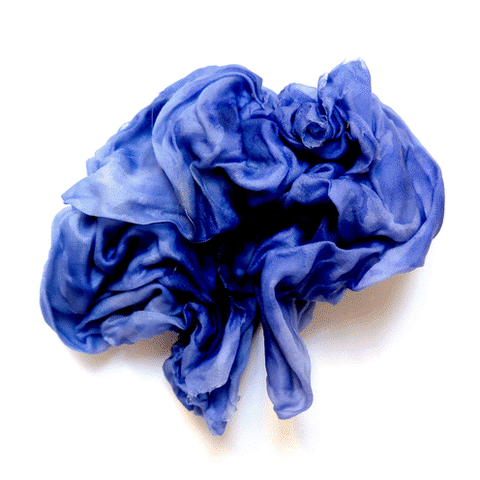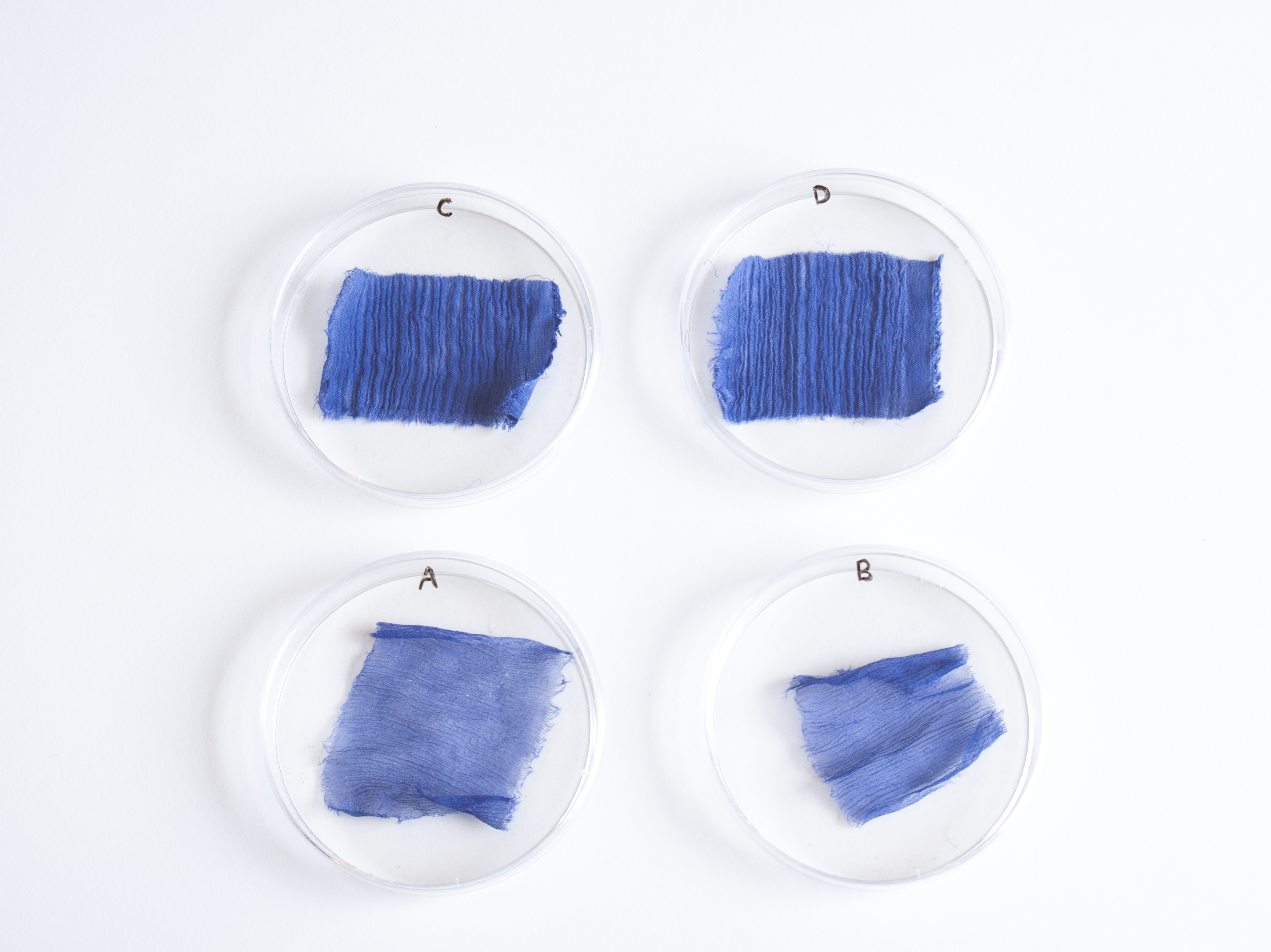4. Biochromes¶
- Produce at least one natural dye or bacterial dye:
- Natural dye - modifying it’s colour and mordanting it in different ways to dye at least 2 different categories of fibers
- Bacterial dye - Explored dyeing with bacteria of different fibers and/or bacteria
- Produce at least one botanical or bacterial ink:
- Botanical Ink - explore different materials, recipes and understand how to adjust them based on the ingredients
- Bacterial Ink - explore bacteria solvents and understand how to adjust or use the inks
- Document your recipes, the ingredients and process and if there have been changes, document your unexpected discoveries
- Name your materials, classify them by typology and display them in a systematic order of samples.
- EXTRA POINT Submit some of your swatches to the analog material library of your lab. (20cm *20cm aprox)
Research¶

from fabtextile.org, see also bioshade.bio

Living colours, Laura Luchtman & Ilfa Siebenhaar

Microbial me, Mellissa Fischer
This week I worked on natural dyes. Since I was in the Polish mountains (Babia Gora), I took the opportunity to use local materials.
Desesperately seeking colors...
Materials¶
- Sumac leaves, fruits and twig
- Raspberries from garden
- Nettle
- Wild rose fruits
- Bark
- Pine needle
- Fern leaves
- Privet berries and leaves
- Lily of the valley leaves
- Dried beetroot
- Curcuma powder
Here is a summary of what I used so far, with respective quantities :
| Material | Quantity (grams) |
|---|---|
| Sumac leaves and twig | 19 |
| Sumac fruits | 181 |
| Privet berries and twig | 204 |
| Raspberries | 152 |
| Nettle | 25 |
| Wild rose fruits | 119 |
| Bark | 60 |
| Dried beetroot | 100 ~ equiv 1kg rehydrated |
| Curcuma powder | 10 |
| Monk cloth fabric (cotton) | 193 |
In Poland there is a tradional soup called Barszcz which is made out of beetroots. This soup requires a large amount of beetroots (minimum 5) to produce enough juice. This is why it is common to find beetroots concentrate or dried beetroots in supermarkets. I bought for 0.50 euros 100g of dried beetroots, which equals 1kg of rehydrated beetroot.
Fabric scouring¶
The only fabric I had was monk cloth, which is made of cotton. As a consequence, I used exclusively vegetal fibers. I started by weighting the fibers : 193g. I prepared the fabric by washing it with neutral soap and soaking it in 2L of water with 2tsp of soda. I left it soak in boiling water for 1h.
After this, the remaining water is brownish-yellowish, probably due to the wax contained in fabrics.
Tannin¶
Tannin is crucial when dealing with cellulose fabric. Conversely, animal fabric has less difficulty to retain the dye in its fiber. Vegetal fabric particularly need tannin to be able to be dyed. On my way to the forest, I have seen several sumac trees, and I asked local citizens if I could pick fruits from their garden, which they kindly accepted.
Sumac trees
Fortunately, sumac leaves have a high concentration of tannin. That is why I decided to do a DIY tannin by boiling the sumac leaves.
There is a significant color difference of the fabric after the tannin bath (on the right) :
Moreover, I experimented with the tannin at different steps of the process of natural dye production : as a pre-mordant bath, or mixing tannin with the dye. I also used different concentration of sumac to see if it could impact the final dye.
Mordanting¶
Mordants facilitate the bonding of the dyestuff to the fibre. I splitted the fibers in two batches : one with diluated vinegar (ratio 1:4) as a mordant, and the other with going through the tannin bath first then the mordant bath with vinegar. I let the fibers soak for 1 day.
Dying¶
In order to create natural dyes, I soaked each material in boiling water for at least 1 hour. I used twice as much water as materials.
Then I strained the juice to filter the pieces. Eventually, I kept the leftovers so as to reuse them.
Samples
I made more than 1L of beetroot dye. Hopefully, I would be able to use all this beetroot juice, by experimenting with modifiers.
Beetroot¶
I used two different concentrations of beetroot : the higher concentrated (1kg beetroot : 0.2L water) produces a dark red with blue undertones; while the lower concentrated (1kg beetroot : 1,5L water) is more pink.
Sumac¶
I got quite good results with sumac. Since it is rich in tannin, it pigments a lot the fabric.
Sumac produces a beautiful coral orange, and turns green or brown with soda.
Raspberry¶
I am satisfied with the results I obtained with raspberry : vibrant pink and greens. The added tannin significantly improves the color.
Privet¶
Privet berries are poisonous so I was particularly careful when using this dye. I obtained from this dye a wide range of colors : purple, blue, green and yellow-brown. Soda reveals blue undertones and depending the amount added it turns to green of yellow-brown.
Wild rose¶
The tint of the wild rose was way more subtle, between beige and orange depending on the modifier or tannin involved.
Nettle¶
Regarding nettle, I believe not having enough concentrated the leaves, because the tint is very subtle.
Nevertheless, the tannin in dye gives a better result in terms of retaining colors.
Bark¶
I didn't manage to dye with bark. The dying itself was very clear. I suppose that I should have boiled a larger amount of bark.
Modifiers¶
I used soda, lemon, vinegar and rust as modifiers.
Modifying beetroot (left) and rapsberry (right) with soda
Baking soda turns the fabric blue-purple, revealing the blue undertones of the beetroot and raspberry.
Final palette¶
Recycling leftovers¶
I used my leftovers to make both ink and prints.
Ink¶
The high concentrated beetroot dye was already so thick that I didn't need to add gum to produce ink.
Print¶
Bacterials dyes¶
Todo